Analysis of the Australian Aged Care System and Its Impact
VerifiedAdded on 2022/08/29
|6
|1528
|18
Essay
AI Summary
This essay provides an overview of the aged care system in Australia, focusing on how it supports the health and well-being of the elderly population. It details the different types of care available, including in-home care, nursing homes, and residential facilities, and highlights the role of the Federal Government in funding and regulating the system. The essay discusses key programs like the Commonwealth Health Support Program (CHSP) and Home Care Packages (HCP), which provide subsidized care and support. It also touches upon the Consumer Directed Care (CDC) services and the challenges within the system, such as gaps between policies and implementation, and the role of informal carers. The conclusion emphasizes the organized nature of the Australian aged care system, while acknowledging areas for improvement and the government's commitment to providing quality services to its elderly citizens. References from various academic journals and studies support the analysis.
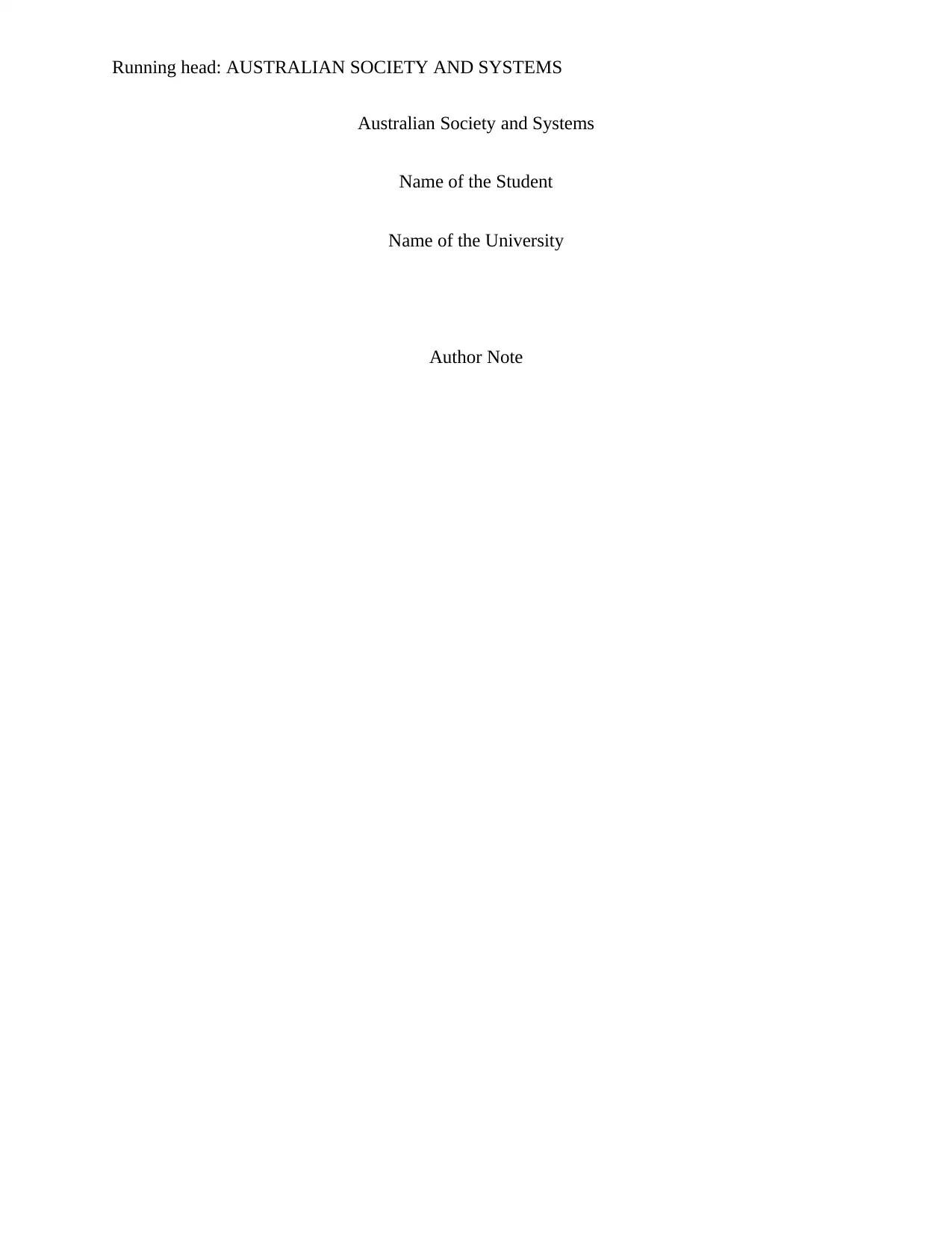
Running head: AUSTRALIAN SOCIETY AND SYSTEMS
Australian Society and Systems
Name of the Student
Name of the University
Author Note
Australian Society and Systems
Name of the Student
Name of the University
Author Note
Paraphrase This Document
Need a fresh take? Get an instant paraphrase of this document with our AI Paraphraser
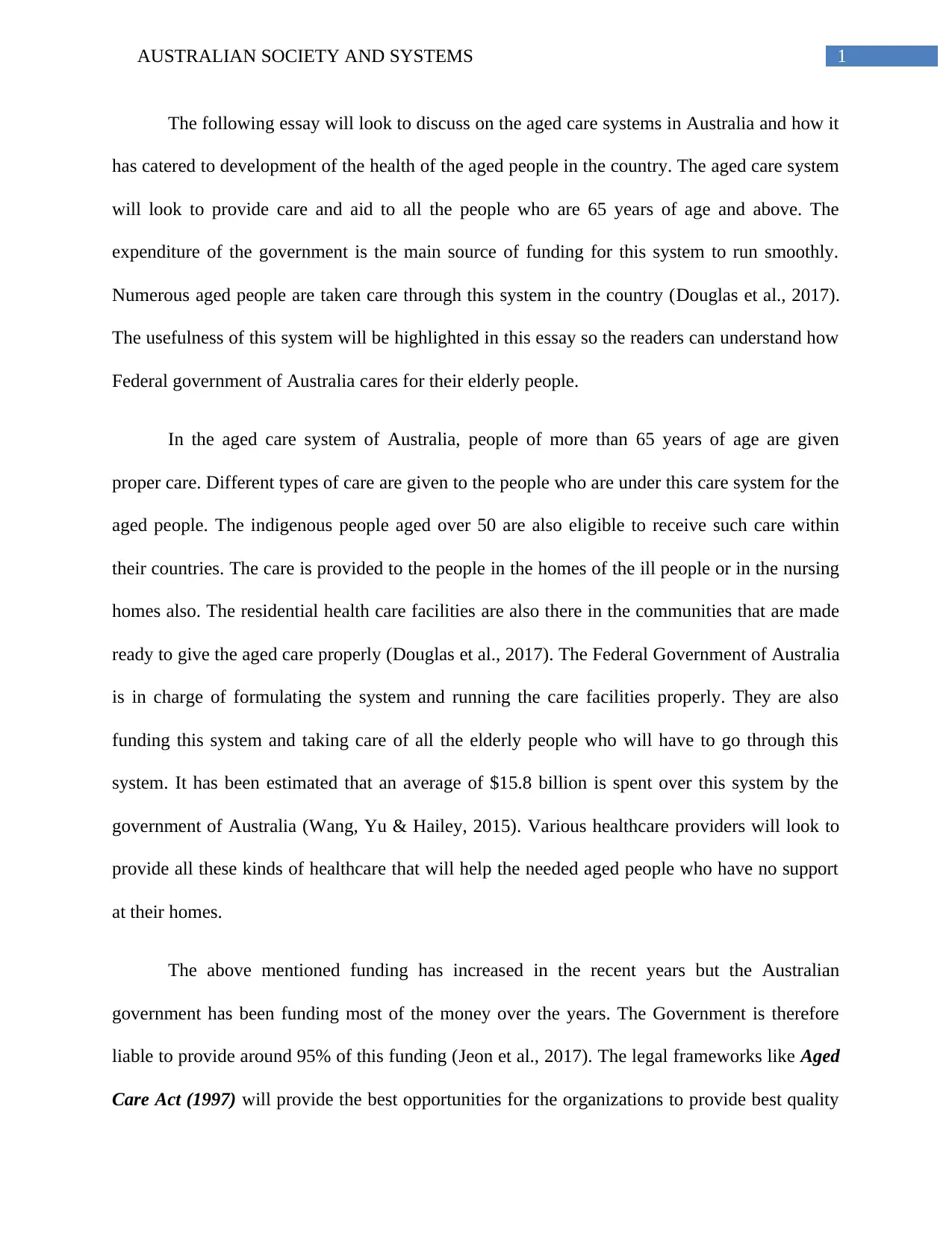
1AUSTRALIAN SOCIETY AND SYSTEMS
The following essay will look to discuss on the aged care systems in Australia and how it
has catered to development of the health of the aged people in the country. The aged care system
will look to provide care and aid to all the people who are 65 years of age and above. The
expenditure of the government is the main source of funding for this system to run smoothly.
Numerous aged people are taken care through this system in the country (Douglas et al., 2017).
The usefulness of this system will be highlighted in this essay so the readers can understand how
Federal government of Australia cares for their elderly people.
In the aged care system of Australia, people of more than 65 years of age are given
proper care. Different types of care are given to the people who are under this care system for the
aged people. The indigenous people aged over 50 are also eligible to receive such care within
their countries. The care is provided to the people in the homes of the ill people or in the nursing
homes also. The residential health care facilities are also there in the communities that are made
ready to give the aged care properly (Douglas et al., 2017). The Federal Government of Australia
is in charge of formulating the system and running the care facilities properly. They are also
funding this system and taking care of all the elderly people who will have to go through this
system. It has been estimated that an average of $15.8 billion is spent over this system by the
government of Australia (Wang, Yu & Hailey, 2015). Various healthcare providers will look to
provide all these kinds of healthcare that will help the needed aged people who have no support
at their homes.
The above mentioned funding has increased in the recent years but the Australian
government has been funding most of the money over the years. The Government is therefore
liable to provide around 95% of this funding (Jeon et al., 2017). The legal frameworks like Aged
Care Act (1997) will provide the best opportunities for the organizations to provide best quality
The following essay will look to discuss on the aged care systems in Australia and how it
has catered to development of the health of the aged people in the country. The aged care system
will look to provide care and aid to all the people who are 65 years of age and above. The
expenditure of the government is the main source of funding for this system to run smoothly.
Numerous aged people are taken care through this system in the country (Douglas et al., 2017).
The usefulness of this system will be highlighted in this essay so the readers can understand how
Federal government of Australia cares for their elderly people.
In the aged care system of Australia, people of more than 65 years of age are given
proper care. Different types of care are given to the people who are under this care system for the
aged people. The indigenous people aged over 50 are also eligible to receive such care within
their countries. The care is provided to the people in the homes of the ill people or in the nursing
homes also. The residential health care facilities are also there in the communities that are made
ready to give the aged care properly (Douglas et al., 2017). The Federal Government of Australia
is in charge of formulating the system and running the care facilities properly. They are also
funding this system and taking care of all the elderly people who will have to go through this
system. It has been estimated that an average of $15.8 billion is spent over this system by the
government of Australia (Wang, Yu & Hailey, 2015). Various healthcare providers will look to
provide all these kinds of healthcare that will help the needed aged people who have no support
at their homes.
The above mentioned funding has increased in the recent years but the Australian
government has been funding most of the money over the years. The Government is therefore
liable to provide around 95% of this funding (Jeon et al., 2017). The legal frameworks like Aged
Care Act (1997) will provide the best opportunities for the organizations to provide best quality
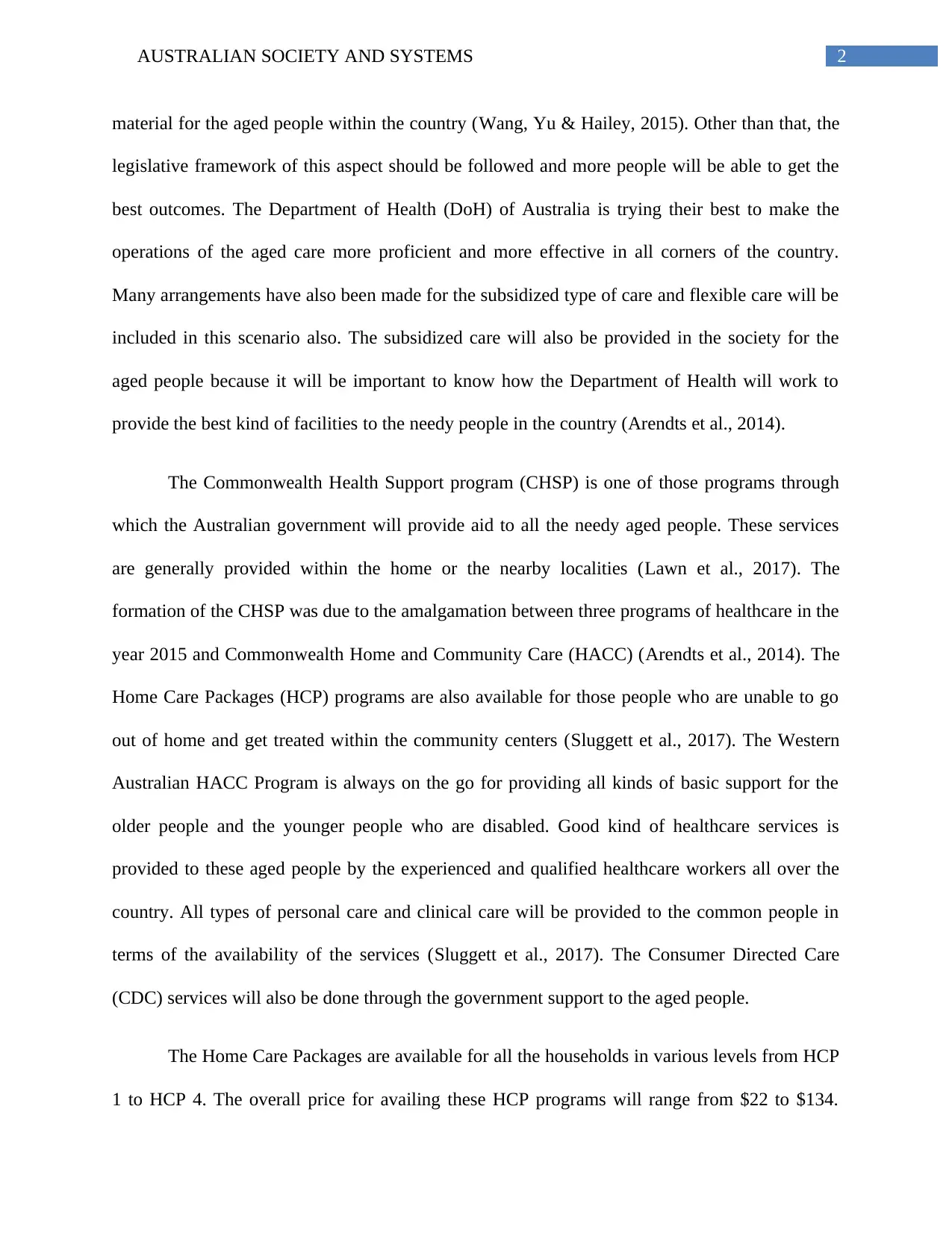
2AUSTRALIAN SOCIETY AND SYSTEMS
material for the aged people within the country (Wang, Yu & Hailey, 2015). Other than that, the
legislative framework of this aspect should be followed and more people will be able to get the
best outcomes. The Department of Health (DoH) of Australia is trying their best to make the
operations of the aged care more proficient and more effective in all corners of the country.
Many arrangements have also been made for the subsidized type of care and flexible care will be
included in this scenario also. The subsidized care will also be provided in the society for the
aged people because it will be important to know how the Department of Health will work to
provide the best kind of facilities to the needy people in the country (Arendts et al., 2014).
The Commonwealth Health Support program (CHSP) is one of those programs through
which the Australian government will provide aid to all the needy aged people. These services
are generally provided within the home or the nearby localities (Lawn et al., 2017). The
formation of the CHSP was due to the amalgamation between three programs of healthcare in the
year 2015 and Commonwealth Home and Community Care (HACC) (Arendts et al., 2014). The
Home Care Packages (HCP) programs are also available for those people who are unable to go
out of home and get treated within the community centers (Sluggett et al., 2017). The Western
Australian HACC Program is always on the go for providing all kinds of basic support for the
older people and the younger people who are disabled. Good kind of healthcare services is
provided to these aged people by the experienced and qualified healthcare workers all over the
country. All types of personal care and clinical care will be provided to the common people in
terms of the availability of the services (Sluggett et al., 2017). The Consumer Directed Care
(CDC) services will also be done through the government support to the aged people.
The Home Care Packages are available for all the households in various levels from HCP
1 to HCP 4. The overall price for availing these HCP programs will range from $22 to $134.
material for the aged people within the country (Wang, Yu & Hailey, 2015). Other than that, the
legislative framework of this aspect should be followed and more people will be able to get the
best outcomes. The Department of Health (DoH) of Australia is trying their best to make the
operations of the aged care more proficient and more effective in all corners of the country.
Many arrangements have also been made for the subsidized type of care and flexible care will be
included in this scenario also. The subsidized care will also be provided in the society for the
aged people because it will be important to know how the Department of Health will work to
provide the best kind of facilities to the needy people in the country (Arendts et al., 2014).
The Commonwealth Health Support program (CHSP) is one of those programs through
which the Australian government will provide aid to all the needy aged people. These services
are generally provided within the home or the nearby localities (Lawn et al., 2017). The
formation of the CHSP was due to the amalgamation between three programs of healthcare in the
year 2015 and Commonwealth Home and Community Care (HACC) (Arendts et al., 2014). The
Home Care Packages (HCP) programs are also available for those people who are unable to go
out of home and get treated within the community centers (Sluggett et al., 2017). The Western
Australian HACC Program is always on the go for providing all kinds of basic support for the
older people and the younger people who are disabled. Good kind of healthcare services is
provided to these aged people by the experienced and qualified healthcare workers all over the
country. All types of personal care and clinical care will be provided to the common people in
terms of the availability of the services (Sluggett et al., 2017). The Consumer Directed Care
(CDC) services will also be done through the government support to the aged people.
The Home Care Packages are available for all the households in various levels from HCP
1 to HCP 4. The overall price for availing these HCP programs will range from $22 to $134.
⊘ This is a preview!⊘
Do you want full access?
Subscribe today to unlock all pages.

Trusted by 1+ million students worldwide
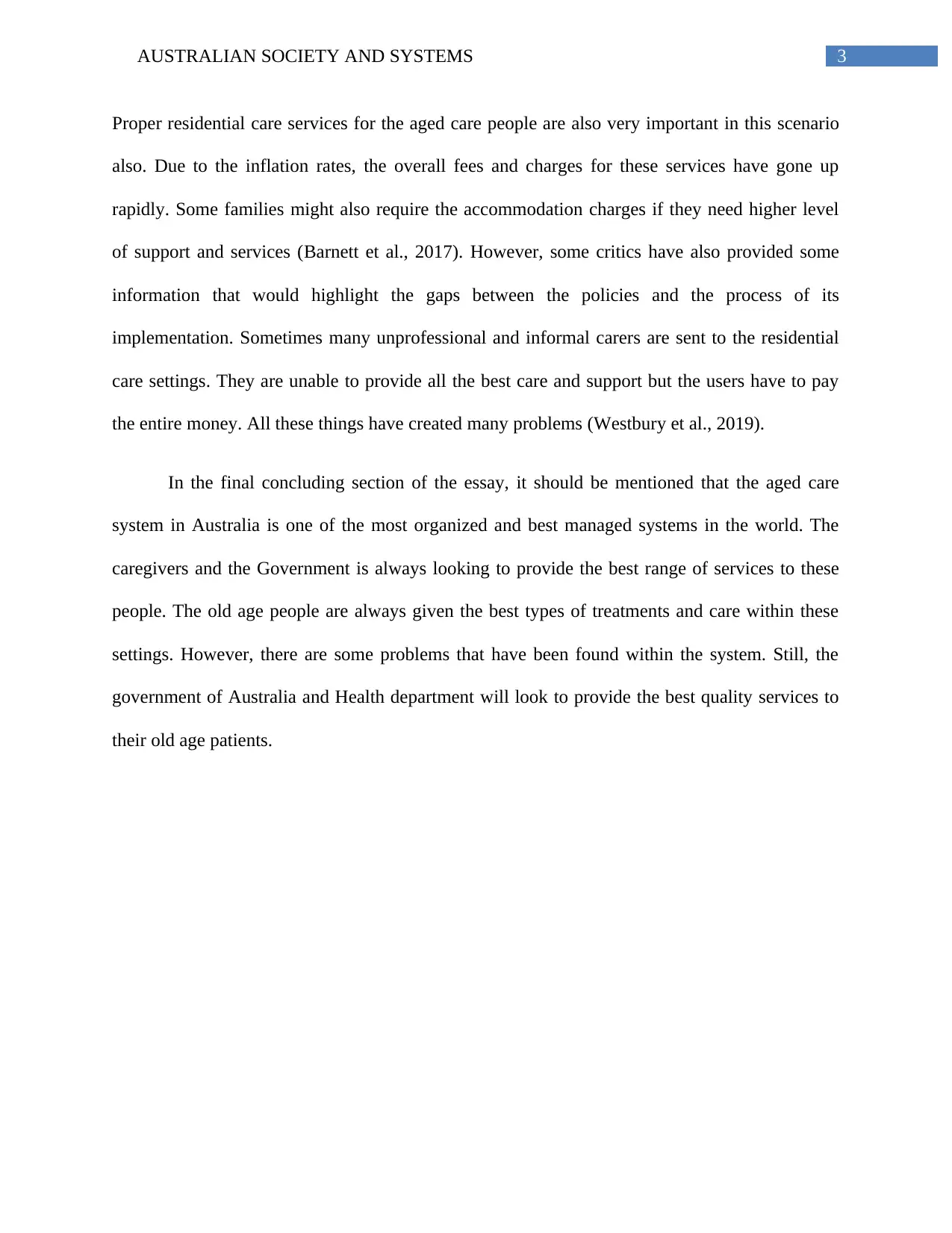
3AUSTRALIAN SOCIETY AND SYSTEMS
Proper residential care services for the aged care people are also very important in this scenario
also. Due to the inflation rates, the overall fees and charges for these services have gone up
rapidly. Some families might also require the accommodation charges if they need higher level
of support and services (Barnett et al., 2017). However, some critics have also provided some
information that would highlight the gaps between the policies and the process of its
implementation. Sometimes many unprofessional and informal carers are sent to the residential
care settings. They are unable to provide all the best care and support but the users have to pay
the entire money. All these things have created many problems (Westbury et al., 2019).
In the final concluding section of the essay, it should be mentioned that the aged care
system in Australia is one of the most organized and best managed systems in the world. The
caregivers and the Government is always looking to provide the best range of services to these
people. The old age people are always given the best types of treatments and care within these
settings. However, there are some problems that have been found within the system. Still, the
government of Australia and Health department will look to provide the best quality services to
their old age patients.
Proper residential care services for the aged care people are also very important in this scenario
also. Due to the inflation rates, the overall fees and charges for these services have gone up
rapidly. Some families might also require the accommodation charges if they need higher level
of support and services (Barnett et al., 2017). However, some critics have also provided some
information that would highlight the gaps between the policies and the process of its
implementation. Sometimes many unprofessional and informal carers are sent to the residential
care settings. They are unable to provide all the best care and support but the users have to pay
the entire money. All these things have created many problems (Westbury et al., 2019).
In the final concluding section of the essay, it should be mentioned that the aged care
system in Australia is one of the most organized and best managed systems in the world. The
caregivers and the Government is always looking to provide the best range of services to these
people. The old age people are always given the best types of treatments and care within these
settings. However, there are some problems that have been found within the system. Still, the
government of Australia and Health department will look to provide the best quality services to
their old age patients.
Paraphrase This Document
Need a fresh take? Get an instant paraphrase of this document with our AI Paraphraser
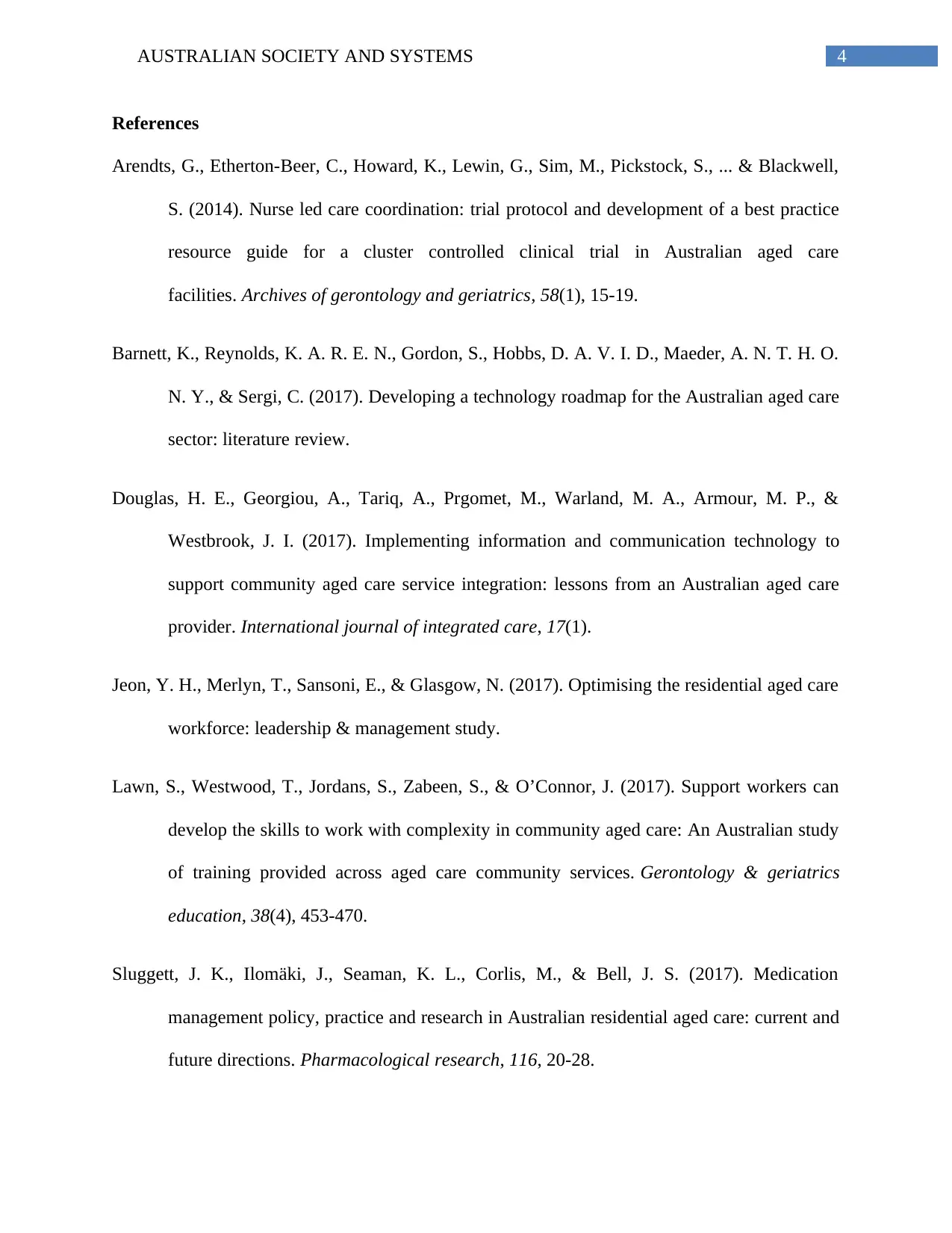
4AUSTRALIAN SOCIETY AND SYSTEMS
References
Arendts, G., Etherton-Beer, C., Howard, K., Lewin, G., Sim, M., Pickstock, S., ... & Blackwell,
S. (2014). Nurse led care coordination: trial protocol and development of a best practice
resource guide for a cluster controlled clinical trial in Australian aged care
facilities. Archives of gerontology and geriatrics, 58(1), 15-19.
Barnett, K., Reynolds, K. A. R. E. N., Gordon, S., Hobbs, D. A. V. I. D., Maeder, A. N. T. H. O.
N. Y., & Sergi, C. (2017). Developing a technology roadmap for the Australian aged care
sector: literature review.
Douglas, H. E., Georgiou, A., Tariq, A., Prgomet, M., Warland, M. A., Armour, M. P., &
Westbrook, J. I. (2017). Implementing information and communication technology to
support community aged care service integration: lessons from an Australian aged care
provider. International journal of integrated care, 17(1).
Jeon, Y. H., Merlyn, T., Sansoni, E., & Glasgow, N. (2017). Optimising the residential aged care
workforce: leadership & management study.
Lawn, S., Westwood, T., Jordans, S., Zabeen, S., & O’Connor, J. (2017). Support workers can
develop the skills to work with complexity in community aged care: An Australian study
of training provided across aged care community services. Gerontology & geriatrics
education, 38(4), 453-470.
Sluggett, J. K., Ilomäki, J., Seaman, K. L., Corlis, M., & Bell, J. S. (2017). Medication
management policy, practice and research in Australian residential aged care: current and
future directions. Pharmacological research, 116, 20-28.
References
Arendts, G., Etherton-Beer, C., Howard, K., Lewin, G., Sim, M., Pickstock, S., ... & Blackwell,
S. (2014). Nurse led care coordination: trial protocol and development of a best practice
resource guide for a cluster controlled clinical trial in Australian aged care
facilities. Archives of gerontology and geriatrics, 58(1), 15-19.
Barnett, K., Reynolds, K. A. R. E. N., Gordon, S., Hobbs, D. A. V. I. D., Maeder, A. N. T. H. O.
N. Y., & Sergi, C. (2017). Developing a technology roadmap for the Australian aged care
sector: literature review.
Douglas, H. E., Georgiou, A., Tariq, A., Prgomet, M., Warland, M. A., Armour, M. P., &
Westbrook, J. I. (2017). Implementing information and communication technology to
support community aged care service integration: lessons from an Australian aged care
provider. International journal of integrated care, 17(1).
Jeon, Y. H., Merlyn, T., Sansoni, E., & Glasgow, N. (2017). Optimising the residential aged care
workforce: leadership & management study.
Lawn, S., Westwood, T., Jordans, S., Zabeen, S., & O’Connor, J. (2017). Support workers can
develop the skills to work with complexity in community aged care: An Australian study
of training provided across aged care community services. Gerontology & geriatrics
education, 38(4), 453-470.
Sluggett, J. K., Ilomäki, J., Seaman, K. L., Corlis, M., & Bell, J. S. (2017). Medication
management policy, practice and research in Australian residential aged care: current and
future directions. Pharmacological research, 116, 20-28.
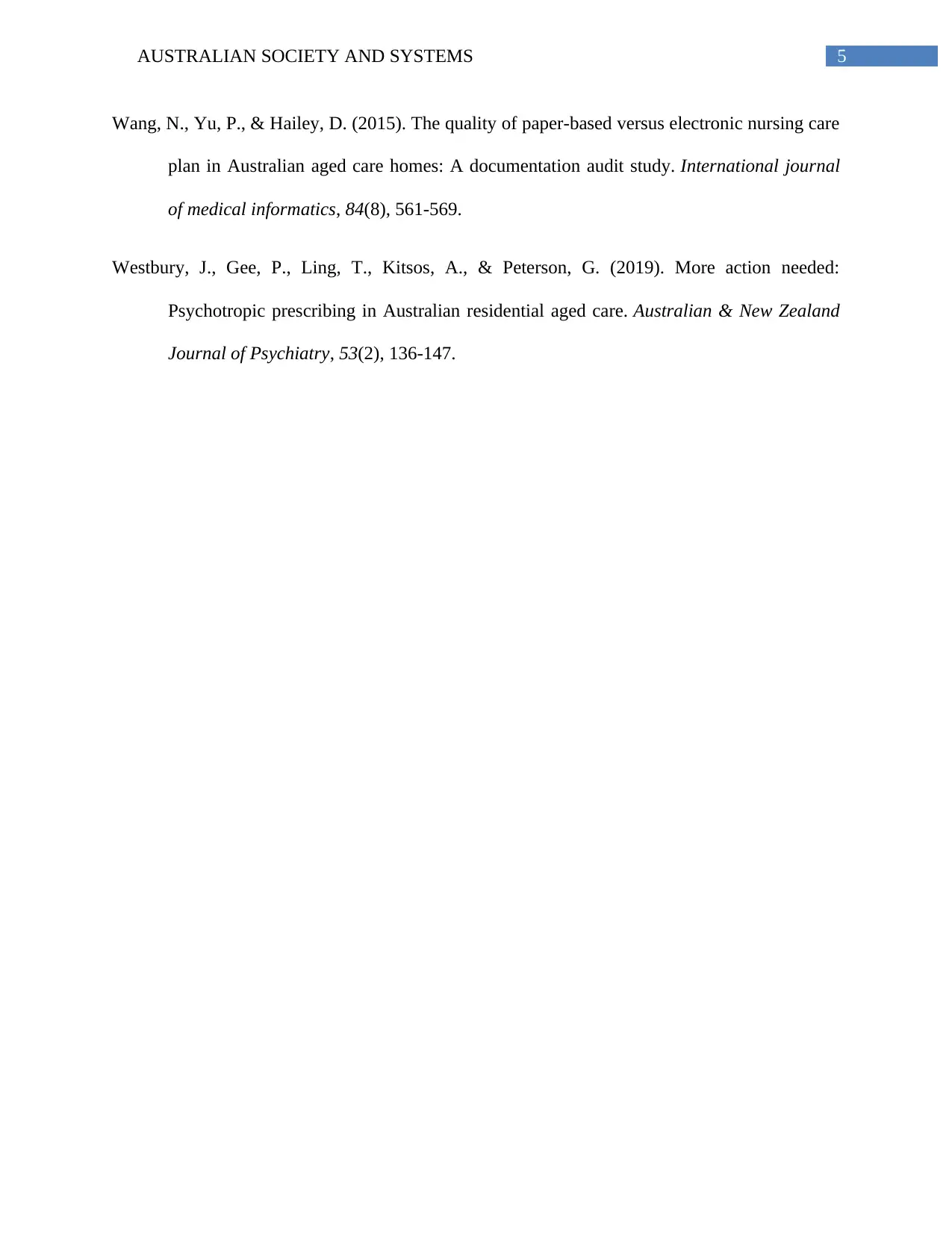
5AUSTRALIAN SOCIETY AND SYSTEMS
Wang, N., Yu, P., & Hailey, D. (2015). The quality of paper-based versus electronic nursing care
plan in Australian aged care homes: A documentation audit study. International journal
of medical informatics, 84(8), 561-569.
Westbury, J., Gee, P., Ling, T., Kitsos, A., & Peterson, G. (2019). More action needed:
Psychotropic prescribing in Australian residential aged care. Australian & New Zealand
Journal of Psychiatry, 53(2), 136-147.
Wang, N., Yu, P., & Hailey, D. (2015). The quality of paper-based versus electronic nursing care
plan in Australian aged care homes: A documentation audit study. International journal
of medical informatics, 84(8), 561-569.
Westbury, J., Gee, P., Ling, T., Kitsos, A., & Peterson, G. (2019). More action needed:
Psychotropic prescribing in Australian residential aged care. Australian & New Zealand
Journal of Psychiatry, 53(2), 136-147.
⊘ This is a preview!⊘
Do you want full access?
Subscribe today to unlock all pages.

Trusted by 1+ million students worldwide
1 out of 6
Related Documents
Your All-in-One AI-Powered Toolkit for Academic Success.
+13062052269
info@desklib.com
Available 24*7 on WhatsApp / Email
![[object Object]](/_next/static/media/star-bottom.7253800d.svg)
Unlock your academic potential
Copyright © 2020–2025 A2Z Services. All Rights Reserved. Developed and managed by ZUCOL.




